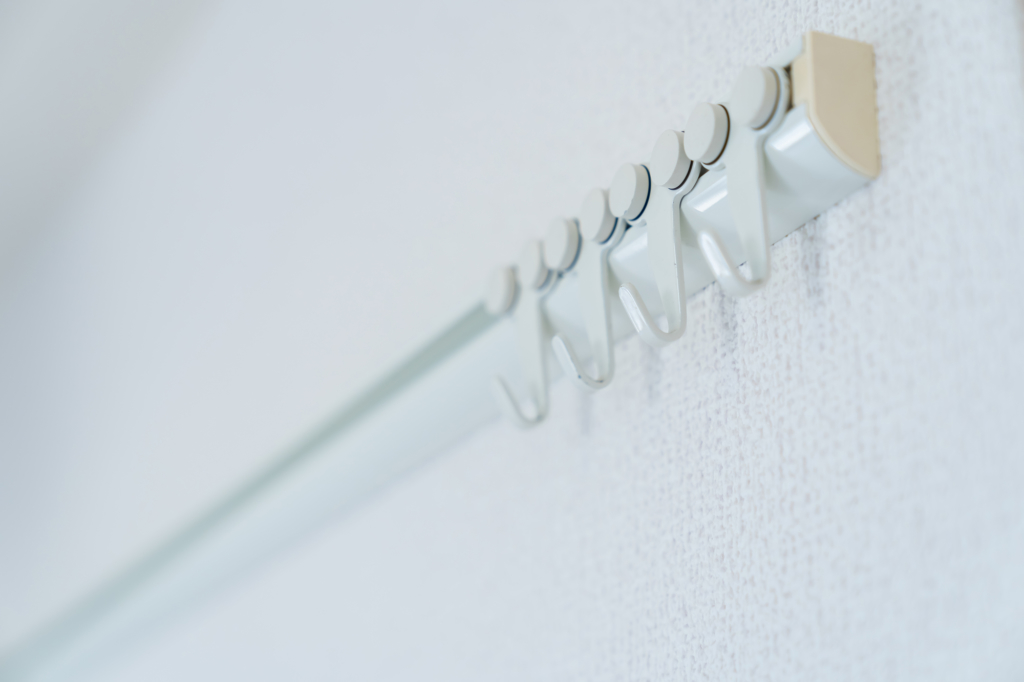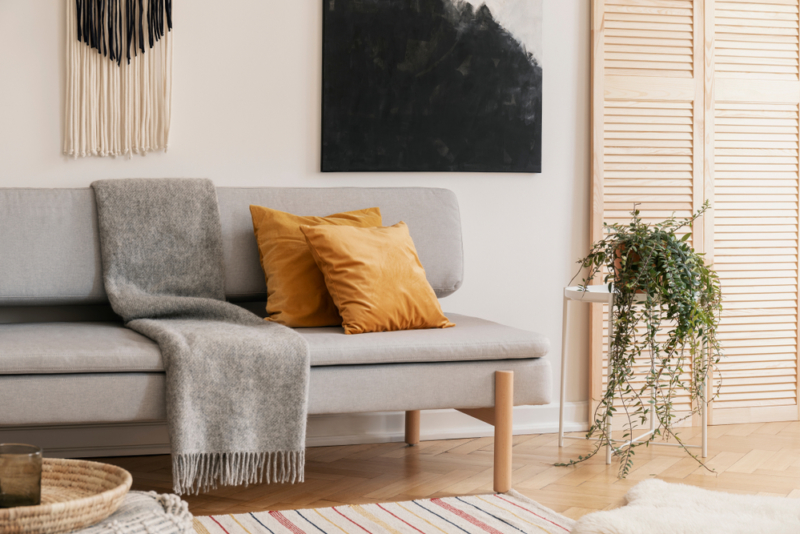If you don’t know about Japanese apartments, read on to learn more – if not, skip ahead to the tips!
The Pros of a Small Apartment

A small Japanese apartment might not be your first choice, but there are definitely upsides. Depending on where you are, they can be some of the most affordable places on the market, so they could potentially save up quite a bit of yen from cheaper rent alone. You can search for some great property options to rent in Japan with Japan Property, one of the leading property portal websites in Japan!
Plus, Japan’s humid summers and chilly winters mean that you’ll be relying on air conditioning and heating for comfort, and a smaller space means less money towards energy bills.
Without extra rooms, you’ll also save precious time and effort cleaning. Finally, rest assured that you won’t be alone – compact rooms are the norm for students and young professionals all around Japan, meaning there’s plenty of affordable furniture and gadgets geared towards this exact lifestyle!
Apartment Layouts: From 1R to 1LDK

Japanese apartments are categorized by number of bedrooms, represented by a number, and whether it has a separate living, dining and kitchen area, represented by the letters L, D, and K respectively. Note that the living, dining, and kitchen areas will generally be combined in one room.
For example, a 1DK apartment won’t contain three separate rooms, but instead one bedroom and one other room deemed big enough to serve as both a living and dining room. On a floor plan, the bedrooms will be marked with either 洋室 (yōshitsu), meaning a Western-style room, or 和室 (washitsu), meaning a Japanese-style room with tatami mats.

1R (ワンルーム)
A one room studio apartment is referred to as ワンルーム (wanrūmu), also abbreviated as 1R. As its name suggests, the main apartment space is truly one room, with no wall or door to separate the bedroom/living area and the kitchen, which you’ll walk into right after opening the front door. Of course, the bathroom has its own area, but it’ll generally be a “unit bath” (ユニットバス / yunitto basu), which combines the bathtub, sink, and bath in one compact room.

1K, 1DK, and 1LDK
Other affordable options include 1K, 1DK, and 1LDK. A 1K apartment is much like 1R in terms of available space and layout, except that there’s usually a door separating the kitchen from the bedroom area. As a result, you probably won’t notice many differences between the two, aside from being able to shut out kitchen and laundry noise and smells to some extent—if you get that extra door.
The example below features not only a separate Western-style main room (marked 洋室 / yōshitsu) and kitchen (台所 / daidokoro), but also a bathroom with a separate sink (洗面 / senmen), bath (浴室 / yokushitsu), and toilet areas.

The next step up is 1DK, which features a larger combined dining/kitchen area in addition to a regular room. The toilet and bath are more likely than 1R and 1K to be in separate areas, although many still have unit baths only. Meanwhile, 1LDK apartments also technically contain two main rooms (a bedroom and combined living/dining/kitchen area), but usually offer more space and built-in storage overall.
Deciding on an Apartment Type

Regardless of which kind of room you’re looking to move into, be sure to familiarize yourself with different options and see what you’re willing to compromise on. Even bigger apartments might still have compact unit baths or only one burner in the kitchen, while small apartments could have more closet space than you expect.
Also, pay attention to the designated washing machine space. Some are inside, while others are out on the balcony. If you can’t find one at all, you’ll be expected to use a communal laundry room or a coin laundry. For more detailed information on Japan’s apartment types, visit our article here!
Optimizing Your Living Space
So you’re thinking about renting a nice new apartment, and now you’re wondering what to put inside it. Or maybe you’ve already lived in that same one room for a while and it’s getting a little cramped. Read on for some handy tips to create a more comfortable living space!
Find Space-friendly Furniture

When you only have one or two rooms to work with, it’s a good idea to be smart with the furniture you choose. A bed, a sofa, a study desk, a coffee table, a bookshelf… It all adds up very quickly in terms of both money and space, so take some time to think about what you really need.
If possible, look for multi-purpose furniture or compact pieces. For example, getting a sofa bed means there’s no need to compromise on space for either sleeping or leisure. If you’d prefer a regular bed, check for models that include cupboards underneath to increase available storage space (something we’ll expand on next!). For more info on what type is right for you, check out our complete guide to Japanese beds!

As for your work/study and leisure space, try a table and a cushioned seat on the floor, rather than a tall Western-style one with a set of chairs that will clutter up your room. Japanese-style tables will often save you even more space, as many are available in compact foldable styles.
Or, seeing as you’re in Japan, why not get yourself a kotatsu (a table with a heater attached to the underside, as in the photo above)? It offers a wonderful source of warmth and comfort, especially because you don’t have to heat up the whole apartment. When it gets less chilly, simply pack away the quilt and you have yourself a normal table.
Another space that can benefit greatly from compact furniture is your balcony. Set out some foldable seats and a table for a nice place to enjoy the weather, or maybe even a cosy little nook just for yourself.
Be Smart With Storage

You don’t have to be a Marie Kondo enthusiast to make your storage spaces more efficient. Try optimizing the room in your bedroom closet and other cupboards with simple containers that allow easier access to different items (and hopefully encourage better organization overall!).
Some bedrooms don’t include poles to hang your clothes, but there’s an answer for that too—look for tension rods and shelves (突っ張り棒 / tsupparibō and 突っ張り棚 / tsupparidana), which are cheap, adjustable, and don’t do any damage to the walls. However, be sure to check the maximum length and weight allowed before purchasing so it doesn’t end up as a new piece of clutter in your room.

It might also be worth cutting down on clothes to set aside some closet space for books and any miscellaneous possessions. Stacking some small shelves inside the closet will make your items easily accessible while keeping them out of the way. For an extreme space-saving hack, you can even turn Japanese-style closets (押入れ / oshiire) into a working space by setting up a light source as necessary and using the shelf in the middle as a desk.
Search For Vertical Space
Don’t despair if your bedroom doesn’t include many built-in storage spaces – instead, look around for vertical space to use, even directly on the walls. Hooks, wall shelves, wire grids… The possibilities are endless, and it’s not limited to the bedroom.
The kitchen and laundry areas also benefit from conveniently located hooks and racks so that you’re not always hunting for utensils or detergent. However, most rentals in Japan are unforgiving of damage from nails and screws, so go with wall-friendly alternatives like Muji’s simple yet sturdy wall-mounted decor.

Most Japanese apartments are also equipped with picture rails, (ピクチャレール) which are metal rails on the wall that are equipped with hooks. They can also be bought separately if your apartment does not come with them. These are also a great option that gives you a lot of freedom to arrange space for both storage and decorations. If you’re more concerned about the latter, try hanging up art pieces, small plants, and so on.
You could even think of the wall itself as your canvas and apply wall stickers or even wallpaper—but make sure they’re the easily removable kind! Taking advantage of vertical space will not only give your room more character but also create the impression of a more spacious room by drawing your eyes upwards.
Show Your Own Style
Maximizing your room’s utility might be important, but that doesn’t mean you can’t add some style too! You’ll find that the majority of apartments feature neutral color schemes – in other words, light beige or white walls plus wooden flooring or tatami mats. Don’t be afraid to add color of your own with stylish curtains, fun bedclothes, and anything else that strikes your fancy.

Greenery like houseplants and mini herb gardens add an especially refreshing touch. Worried about your not-so-green thumb? Try succulents, which are small, cute, and best of all, low-maintenance. You can also add some more depth to the room by adding different light sources in the form of string lights, lamps, and so on. In the end, it’s your room, so go ahead and decorate it in a way that you’ll enjoy!
General tips

Finding a new apartment may be a hectic ordeal, but don’t forget to schedule a visit in person before deciding on one. While the floor plan will give you the area of the room in terms of tatami mats or square meters, it’s difficult to grasp how much space there is without actually seeing it.
It’s also a good idea to write down specific measurements, including the room’s nooks and crannies, as well as your current and planned furniture, appliances, and large accessories. This will eliminate any doubt as to whether something will fit or not.
Moving or rearranging your current room is also a great opportunity to think about what you really need in your day-to-day life, whether it be clothes, knickknacks, or appliances. Consider freeing up some space by selling or donating unneeded belongings through marketplaces like Mercari and online communities like Jimoty.

And if you’re worried about your budget, rest assured there’s no need to splurge for fancy storage gadgets or furniture. Plenty of low-cost options are available at big chain stores like Nitori, and you can also find relatively stylish storage items and accessories at 100 yen stores. If you turn to Mercari and Jimoty as a customer, you might even chance upon affordable yet good quality second-hand furniture and appliances.
Update: You can also save money with coupons for Japanese electronics stores BicCamera, YAMADA DENKI, and EDION.
Conclusion
Even if you’re not used to the size of a Japanese apartment, there are plenty of ways to make it your own – and even enjoy it! Fortunately, Japan has many great solutions to combat space and storage-related problems. With a bit of preparation and effort, your little room will feel like a luxurious space in no time.
If you want to give feedback on any of our articles, you have an idea that you’d really like to see come to life, or you just have a question on Japan, hit us up on our Facebook!
Title image credit: Photographee.eu / Shutterstock.com
The information in this article is accurate at the time of publication.

